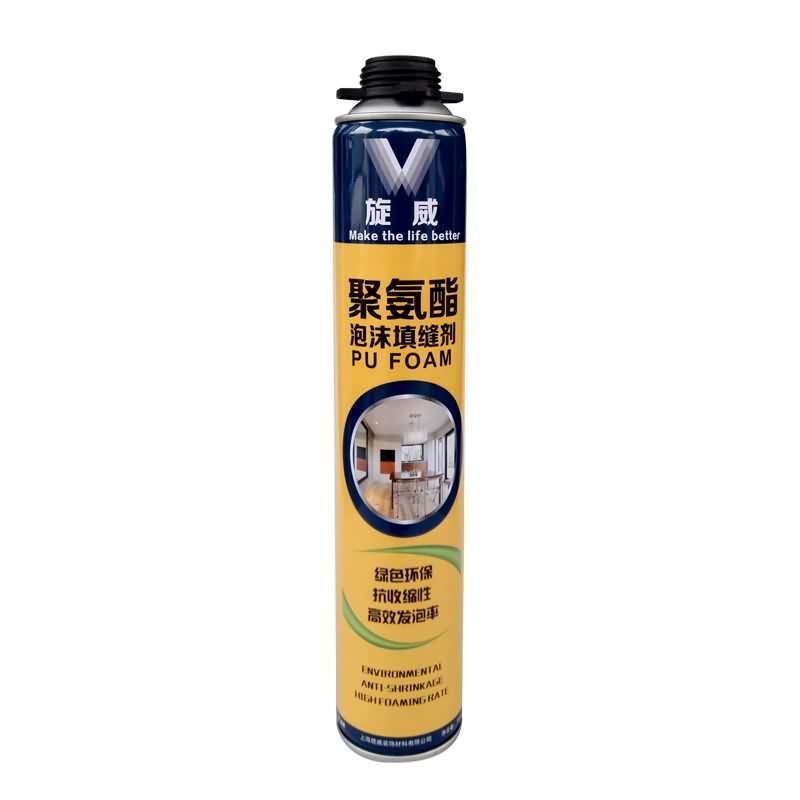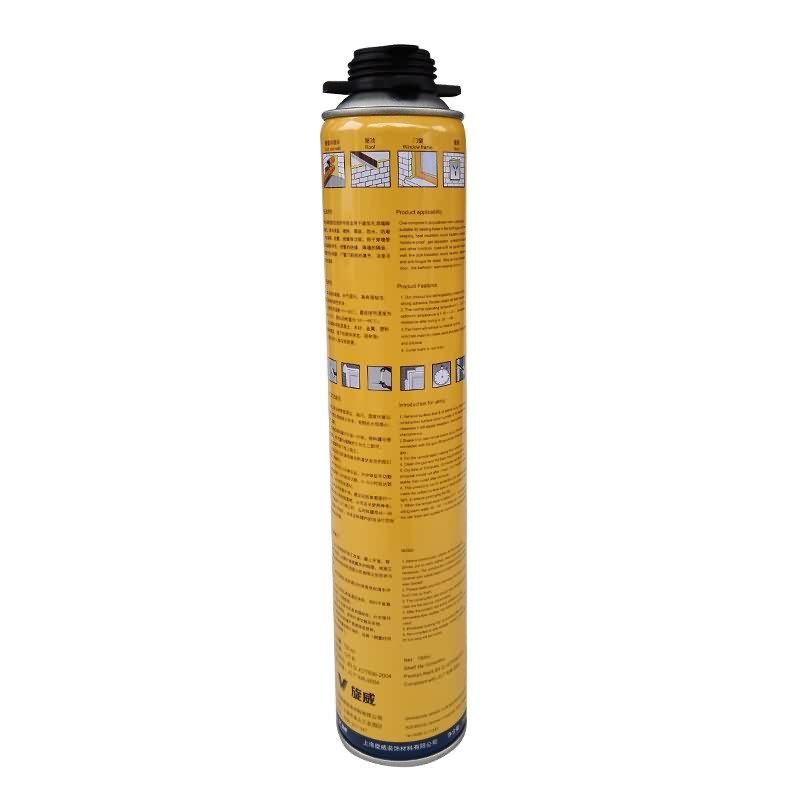26 Years Factory Siway PU FOAM Wholesale to Estonia
Short Description:
Description This product is the expansion, moisture curing, has the strong cohesiveness, elastic foam obturator structure; Save work to save time, reduce waste; High bond strength; Bubble can stick in the concrete, wood, metal, plastic, such as base material surface, but not including teflon, silicon resins; Key Features 1. Noise silencing effect 2. Strong bonding strength 3. Water & weatherproof 4. Primerless adhesion to most building materials Basic Application 1.Doors and Windows a...
To meet the customers' over-expected satisfaction , we have our strong team to provide our best overall service which includes marketing, sales, designing, production, quality controlling, packing, warehousing and logistics for 26 Years Factory Siway PU FOAM Wholesale to Estonia, Our company will continue to adhere to the " superior quality, reputable, the user first " principle wholeheartedly. We warmly welcome friends from all walks of life to visit and give guidance, work together and create a brilliant future!
Description
This product is the expansion, moisture curing, has the strong cohesiveness, elastic foam obturator structure; Save work to save time, reduce waste; High bond strength;
Bubble can stick in the concrete, wood, metal, plastic, such as base material surface, but not including teflon, silicon resins;
Key Features
1. Noise silencing effect
2. Strong bonding strength
3. Water & weatherproof
4. Primerless adhesion to most building materials
Basic Application
1.Doors and Windows and wall body between the gap filling sealing, fixed bond
2.Language lab, studio, etc when decorating, gap to fill
Technical data sheet
|
Project |
Value |
||
|
Density, Kg/m³,Not less |
10 |
||
|
Thermal conductivity,35℃,W/(m·K) no more than |
0.050 |
||
|
Dimensional stability(23±2)℃,48,h no more than |
5 |
||
|
Operating temperature |
-10~+35℃ |
||
|
Optimum operating temperature |
+18~+25℃ |
||
|
Temperature range(After curing) |
-35~+80℃ |
||
|
Tensile bond strength kPa Not less |
Aluminum plate |
Standard condition,7d |
80 |
|
Immersion,7d |
60 |
||
|
PVC plate |
Standard condition,7d |
80 |
|
|
Immersion,7d |
60 |
||
|
Cement Plate |
Standard condition,7d |
60 |
|
|
Shear strength,kpa,Not less |
80 |
||
|
Foam expansion ratio,Not less |
Standard value-10 |
||
Certification
JC 936-2004
Color
White
Package
750ml in Bottle * 12 per box
Shelf life
12 months
Note
If you want the TDS or MSDS or other details, please contact with our sales person.
A brief overview of Trim-Lok, Inc. Southern California’s premier manufacturer of Rubber and Plastic extrusions. Uses include finishing and protecting rough edges, sealing against leaks, minimize effects of vibrations, and decorative mylar applications. Visit us on-line at www.trimlok.com or email us at info@trimlok..com Contact us for a FREE catalog and samples. If You Have An Edge …We Have A Trim.
For more information visit us online at https://www.trimlok.com.
For a FREE CATALOG submit your request online at https://www.trimlok.com/catalog-700
What is TUBELESS TIRE? What does TUBELESS TIRE mean? TUBELESS TIRE meaning – TUBELESS TIRE definition – TUBELESS TIRE explanation.
Source: Wikipedia.org article, adapted under https://creativecommons.org/licenses/by-sa/3.0/ license.
Tubeless tires are pneumatic tires that do not require a separate inner tube.
Unlike pneumatic tires which use a separate inner tube, tubeless tires have continuous ribs molded integrally into the bead of the tire so that they are forced by the pressure of the air inside the tire to seal with the flanges of the metal rim of the wheel.
Many patents had been filed covering tubeless tires. Killen Tire applied for a patent in 1928 and was granted GB patent 329955 in the UK in 1930. The Wingfoot Corporation, a subsidiary of Goodyear Tire were granted a patent in South Africa in 1944. Due to technical problems, most of these designs only saw limited production or were abandoned.
Frank Herzegh working for BF Goodrich applied for a patent in 1946 and eventually received US patent 2587470 in 1952 in the United States. By 1955 tubeless tires became standard equipment on new cars. BF Goodrich had to defend their patent in court several times, due to the similarities of previous designs. The primary difference between the BF Goodrich design and their predecessors was the usage of butyl rubber, which was more resistant to air leakage than the natural rubber used in the other designs.
Traditional designs of pneumatic tires required a separate inner tube which could fail for a number of reasons, such as incorrect tire fit, friction between the tire wall and inner tube generating excess heat, or a puncture. Tubeless tire technology does away with the need for an inner tube thereby increasing safety. In a tubeless tire, the tire and the rim of the wheel form an airtight seal, with the valve being directly mounted on the rim. If a tubeless tire gets a small puncture, air escapes only through the hole, leading to a gentle deflation. Conversely, an inner tube could potentially burst like a balloon, leading to deflation of the tire which could result in sudden loss of control of the vehicle. However, the “bursting like a balloon” scenario is highly unlikely due to fact that the inner tube is inside of the tire and will deflate at a rate proportional to the puncture hole size.
Liquid tire sealant can be injected into tubeless tires to prevent deflation in case of small punctures, although there is controversy regarding its compatibility with direct tire pressure monitoring systems (TPMS) that employ sensors mounted inside the tire. Some manufacturers of sealants assert that their products are indeed compatible, but others warned that, e.g., the “sealant may come in contact with the sensor in a way that renders the sensor TEMPORARILY inoperable until it is properly cleaned, inspected and re-installed by a tyre care professional”. Such doubts are also reported by others. Use of such sealants may void the TPMS sensor warranty.
A tubeless bicycle tire system requires a compatible tire, an airtight rim — capable of being sealed at the valve stem, spoke holes (if they go all the way through the rim) and the tire bead seat. The main benefit of tubeless tires is the ability to use low air pressure for better traction without getting pinch flats because there is no tube to pinch between the rim and an obstacle.
UST or Universal System Tubeless is a US patent 6257676 rim designed by Mavic with hooked edges designed to seal with specially designed tires. Several companies such as Michelin and Hutchinson make tires compatible with UST rims. UST was the first tubeless system for bicycles. Other companies such as Stans Notubes Bontrager, DT Swiss, and WTB have their own similar system called Tubeless Ready.
In 2006, Shimano and Hutchinson introduced a tubeless system for road bicycles. Tubeless tires have not yet gained popular acceptance in road racing due to lack of sponsorship, the tradition of using tubular tires and the fact that, even without the innertube, the combined weight of tubeless rims and tires is more than top-of-the-line tubular tire wheelsets. Road tubeless is gaining popularity among riders for whom the benefits are worth the costs.






